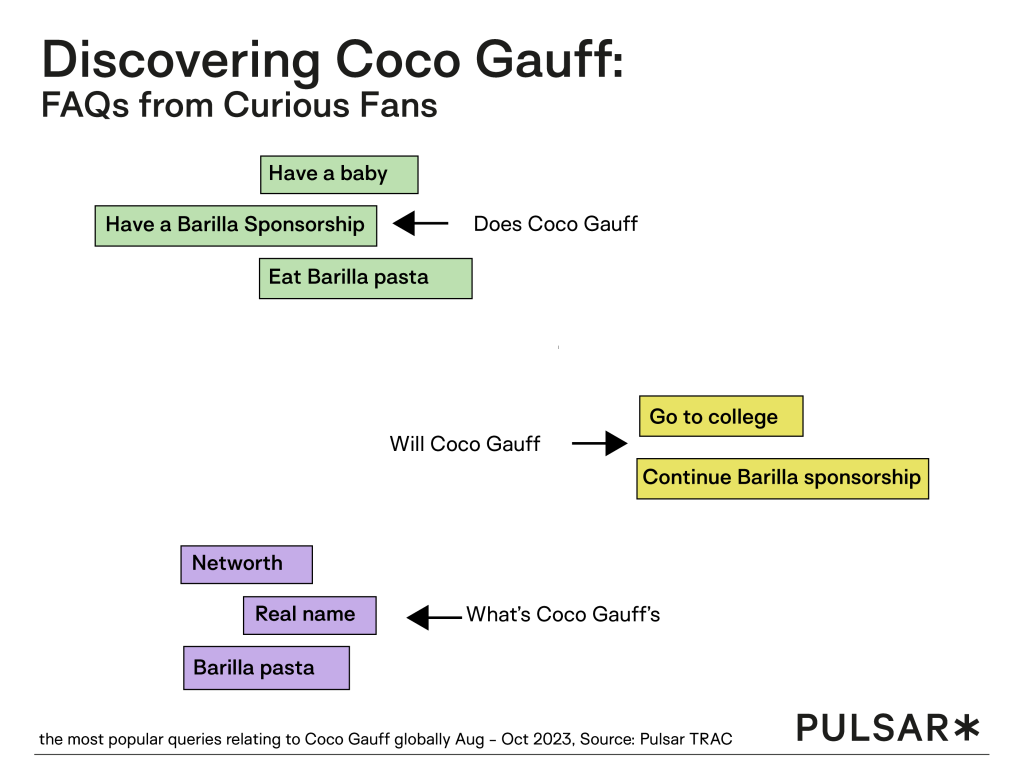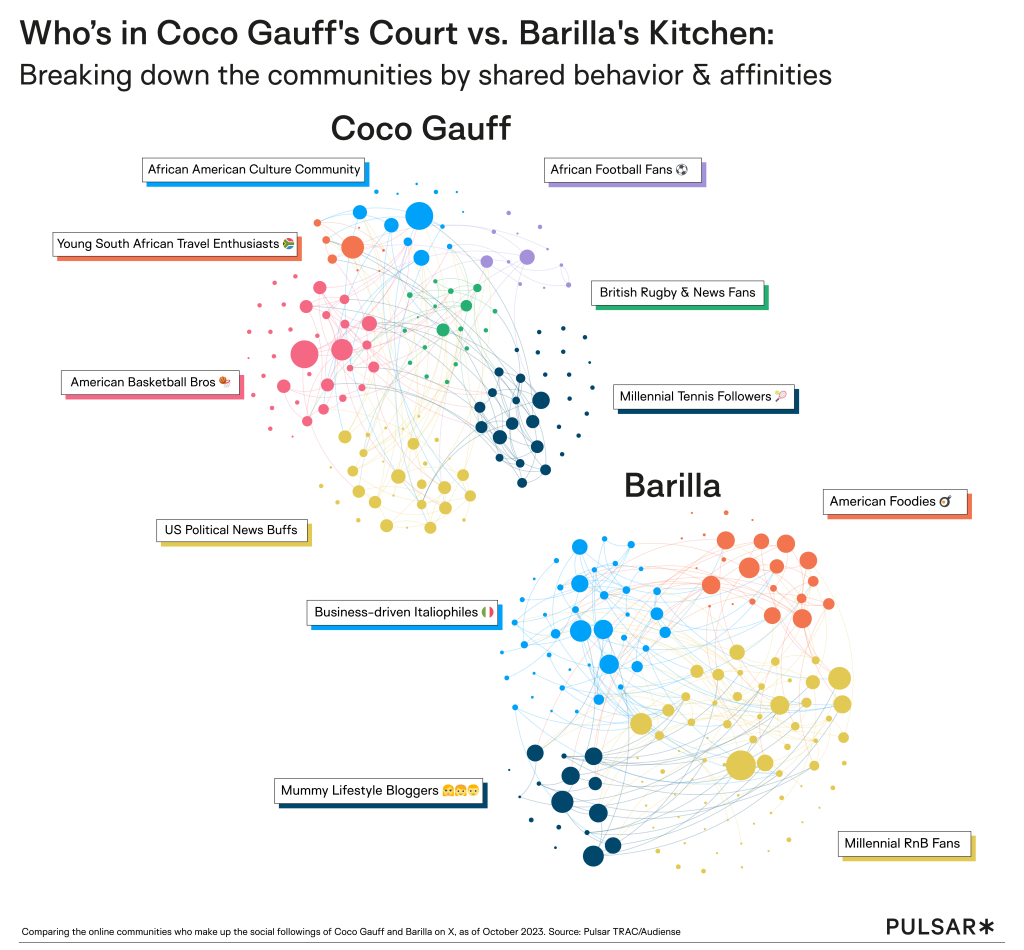
Love – Pasta: Exploring Coco Gauff’s sponsorship with Barilla
- Sport
There's a new star in world tennis. Coco Gauff, after winning the US Open, is one of the most marketable athletes in the world. She's also part of one of the most interesting and unusual sponsorships in sports, which has caught the attention of online audiences for its novelty and what it implies about the parties involved.
That partnership, in case you missed it, is with Barilla, the household pasta brand.
I approve this message @Barilla https://t.co/cYCbGt9ZO5
— Coco Gauff (@CocoGauff) January 20, 2023
Using Pulsar TRAC, we explored the conversation across X/Twitter, news, broadcast, Instagram, and Google search, to illustrate both how the partnership was received, and why it works for Barilla.
For brands, assessing the value of such an expensive maketing channel as sponsorship (in sports or elsewhere) is always tricky: audiences, unprompted, rarely talk about sponsorships at all, which limits brands' ability to measure the effect in terms of brand reach, brand association with the athlete (or teams') fanbase.
The unexpected and prominent appearance of a well-known pasta brand in the place of, say, apparel brands, allows for a deeper analysis of who's reacting and 'why'.
First, the context. The partnership between Gauff and Barilla has been ongoing since she was 14 years old (and she's not the first tennis star to sponsored by the brand, Roger Federer being her pasta predecessor).
After her historic Women's US Open victory, the unconventional sponsorship was drawn further into the spotlight, amongst audiences and publications alike.
Sloane got chocolate milk. Coco got pasta. Emma got Porsche
— john King (@kingkaos3) April 8, 2024
Audiences responded to the novelty, with the perception being that there was almost something iconoclastic or guerrilla about Gauff wearing the logo to one of the sport's most elevated stages.
Not that everyone was such a fan, of course.
New Balance needs to step in and pay Coco whatever Barilla is paying plus a sweetener to get that logo off her on court.
Almost never see Nike or Adidas kits littered with random sponsors. It's diluting NB's whole effort with an athlete who's about to go to another stratosphere.
— Dylan Dittrich (@DylanDittrich) September 8, 2023
The general tone of the reaction suggests that many weren't aware of Federer's previous deal with Barilla, nor their sponsorships with other high-profile athletes, like Michaela Shiffrin.
So why does it work? Why have Barilla diverted so much of their marketing budget towards this one figure?
There's one main reason: the link with health and activity. Pasta is increasingly associated with high-calorie, unhealthy diets. Creating an association between your brand and sports can help shift this association in the minds of audiences. In that sense, a precursor might be Red Bull, who invest in football, motor racing and more.
If that's why tennis, then the second part of the equation is why Gauff in particular?
Clearly, her winning of the US Open has seen her brand awareness and marketability explode. Barilla wouldn't have been able to foresee this, of course, but it's a calculated bet in the sponsorship of any athlete (the flip side, of course, is all the athletes who garner lucrative sponsorship deals before missing a tournament through injury).
One thing Barilla could have seen is the steadily accumulating interest in tennis sponsorships as a topic in of themselves.
Another thing they could have honed in on is the enormous amount of interest in Gauff as a person. While media interest largely focuses on her sporting prowess, and what her success can represent across different demographics, audience interest (signified here by search data) tells a more intimate story.

People are curious about her net worth when she began her tennis journey, her college plans, and her views on starting a family.
In that sense, she is someone relatable elevated by a rare talent. Gauff is therefore the 'right' tennis player, someone who doesn't only embody a type of sporting excellence but also an easy familiarity and wholesomeness that befits the representative of a household pasta brand.
Beyond the media coverage generated through tournaments, what does this partnership look like?
You can see it in action in the brand's 'serving love' campaign. This new line of pasta, which emphasises healthy ingredients and contains "zero additives", is advertised using Gauff (in mid flight).
View this post on Instagram
And if Coco Gauff is invaluable in raising Barilla's visibility, then she can also prove highly useful in activating segments within their existing fanbase.

Take the aforementioned 'serving love' campaign, centred on a healthier pasta alternative. Business-driven Italiophiles within the Barilla audience display strong affinity for sport as a community. The Millennial RnB fans who follow Barilla also share numerous characteristics with many of the African-American communities that make up Gauff's own fandom. That's the two largest Barilla communities, for context, both disposed to listen to and admire the brand's ambassador.
A closer look at Gauff's own audience throws up a surprising insight: they have an affinity for sport, but not necessarily tennis, which comes second to basketball.
This talks to Gauff's star power and currency as an influencer beyond the boundaries of a tennis court. Do Barilla customers all necessarily love tennis? Of course not, but they display affinities for sport, for health, for family, and for inspirational women.
When viewed through this audience-first, behavioral lens, it becomes clear that the Barilla x Coco Gauff sponsorship isn't simply a novelty, but a very smart play.
This article was created using data from TRAC


